AI is Still in Day One, Africa's Surge, Hope for a Superconducting Future, Safest & Cleanest Energy, Humans' Culture of Progress #7
/ 7 min read
 Image Source: DALL-E
Image Source: DALL-E
Finally got the chance to write things down after a long break.
Truth be told, I don’t expect much change in 2024. As optimistic as I am, for the most part, I’d prepare for a rinse-and-repeat of 2023: the same headlines blaring on repeat and the same anxieties buzzing like persistent mosquitoes, but hopefully with the same (accelerated) growth. I thought I was accustomed to not being surprised, but most of the times I failed — I mean, one pandemic and two big wars? Give me a break.
Feels like I am a hummingbird trapped in a predictable sky, flitting between hope and realism. I’m approaching this year like a seasoned amusement park visitor: expect the lines, embrace the repeats, but keep an eye out for the occasional haunted house surprise or malfunctioning robot.
Yet the rebel spirit in me refused to stay put. 2024 might be a well-worn record, but I am no passive listener. I expect to spin it with a new needle, hoping for a hidden track, an unexpected melody. Better yet, a chance to bloom, a chance to twirl, a chance to be anything but ordinary.
Alright. Enough of this nonsense, though.
Let’s get to the more interesting parts. And what better place to start than with the technology that’s both disrupting and defining our world? AI, my friends, is still in its day one.
1. AI is still in day one
This toddler taking its first wobbly steps toward reshaping our reality. The adoption is surging ahead of the previous life-changing technology like the internet and smartphones.
 Source: Coatue
Source: Coatue
Most likely the trend will continue, pushing the growth beyond its current additional USD 2.4 Trillion in terms of equities of big companies like Microsoft, Alphabet, Apple, Tesla, Amazon, Meta, and of the biggest gainer, NVIDIA, which have added more than $1 trillion in value alone.
While the impact of the technology continues to deeply woven into our everyday lives, this doesn’t mean the deflation won’t happen. With a whopping 25% of US venture funding pouring into AI startups, and 4 in 5 American unicorns are now AI-related, concerns of overvaluation linger. Take a look at OpenAI’s and Anthropic’s valuation: 180x and 200x sales, respectively. Which stand in stark contrast to more established players like Uber (3x).
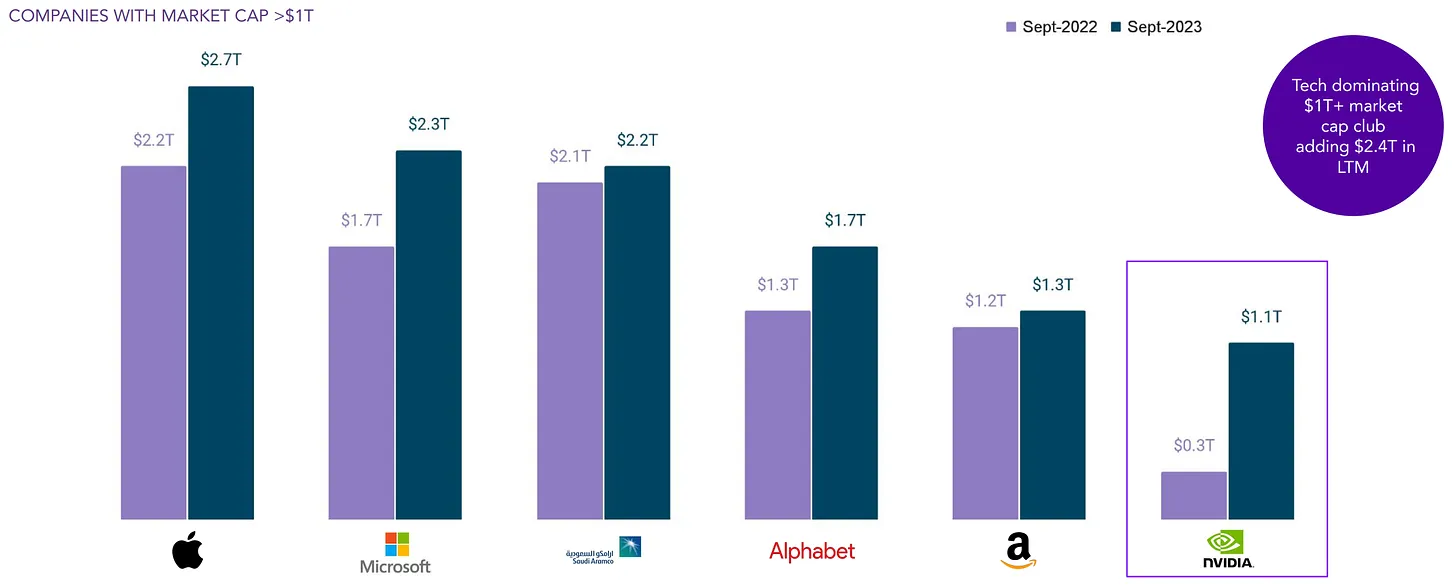 Source: Accel
Source: Accel
Speaking of surging, every peak has its valley. Let’s talk about how we rise, and the potential fall of human civilization.
2. The humans progress: a story of how we rise and collectively decline
What sparked the Industrial Revolution? apparently, it wasn’t just machines and factories.
A recent study by four economists shed light on the theory that cultural shifts paved the way towards the Industrial Revolution. After all, it’s the progress-oriented view of the world, championed by the likes of Francis Bacon, Isaac Newton, and others, that move the needle. Putting science and experimentation as the center to make life better.
To explore this possibility, the researchers use language as a proxy to analyze cultural differences across societies. Like fingerprints in ink, language holds a wealth of cultural insights, such as gender norms, religious norms, including attitudes towards risk and much more. In the paper, the researchers analyzed the contents of 173,031 books printed in England between 1500 and 1900, tracking how frequently terms related to progress changed over time. One of the most interesting findings here is that not only do prosperous nations chatter more about progress, but cultural attitudes actually shift towards optimism before economies take off.
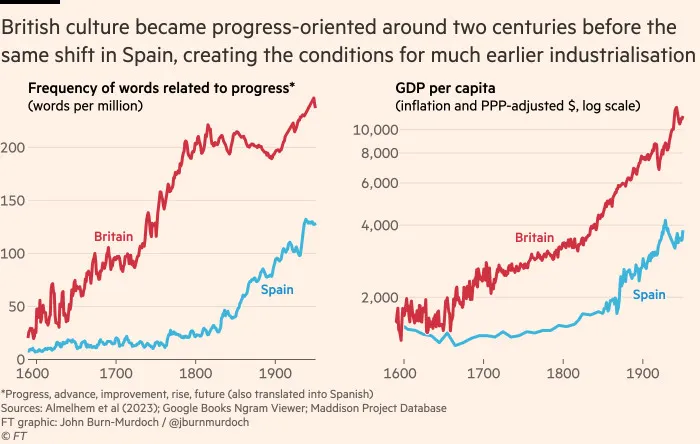 Source: Financial Times
Source: Financial Times
Extending the work into the current decade, there’s a finding that suggests a concerning trend: western culture has been subtly abandoning its historical embrace of progress, innovation, and optimism. By analyzing texts since the 1960s, we can see that there’s a 25% decline in terms associated with progress, and more about anxiety, and risk aversion. One could say that calibrating priorities from perpetual advancement to caution is a good thing, but too much of it can jeopardize our progress e.g Memes. Take that, EU!
 Source: European Commission
Source: European Commission
3. Hope for a Superconducting Future
 Source: Edge-sharing quasi-one-dimensional cuprate gragments in optimally substituted Cu/Pb apatite
Source: Edge-sharing quasi-one-dimensional cuprate gragments in optimally substituted Cu/Pb apatite
Since we are talking about hope and progress. I want to touch a bit on the hope for Superconductivity that will transform the way we generate, transport and consume electric energy. Imagine a world where electricity hums through power lines without a whisper of energy loss, where trains levitate on magnetic tracks and paints a picture of frictionless travel, where computers run 1000x faster than currently, and battery life increased significantly.
In superconductors, something special happens. electrons pair up and act like they’re dancing together, moving through the material with perfect coordination. A phenomenon once confined to the realm of theoretical, now shimmering as a beacon of transformative possibility - two claims onetwo in the past 6 months alone (that I know of)— at least in its earliest shape: floating rocks.
Most superconductors, however, need to be chilled to very low temperature, near absolute zero. Room temperature superconductivity (RTSC) has long been the holy grail, a seemingly impossible dream because finding materials that operate at that practical temperatures has been a scientific hurdle. Fortunately, with each step forward, the dream of a superconducting future draws closer — AI-enabled material exploration tools like GNoME will come in handy.
Recent advancements, including CuxPb10−x(PO4)6O “LK-99”, that was claimed to be the first room-temperature at ambient pressure superconductor sparked an electric storm of excitement and skepticism. It has undergone a roller coaster ride. Not too long ago, following failures in replication attempts (sulfide impurities, ferromagnetism, and incompatible properties) and strong evidence that against the early result, we must forgo the possible breakthrough. But not to be the one who dismissed the possibilities, the team at Lawrence Berkeley National Lab have employed supercomputers to explore ways to make LK99 functional.
In addition, a recent joint paper by two independent researchers from several universities in China and Japan has reignited the possibilities of LK-99 superconductivity at room temperature, although with slightly different formulation than the original LK-99 formula.

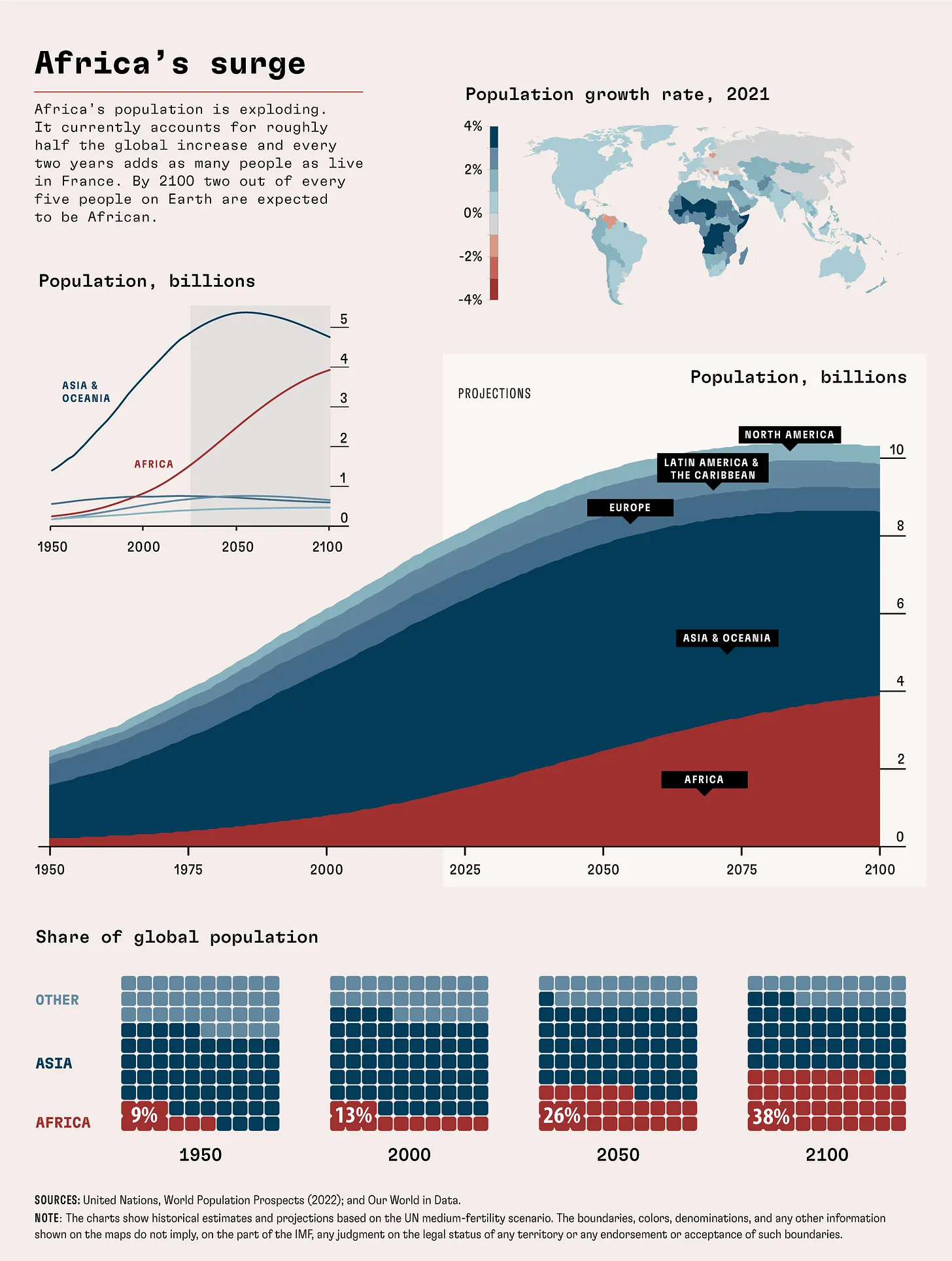 By 2050, Africa’s population would account for a quarter of the world. Where the slowing birth rates are prevalent in other parts of the world, Africa would remain as the largest source of growth. With this shift in population, some of these states possibly emerge as new world powers. Source: IMF
By 2050, Africa’s population would account for a quarter of the world. Where the slowing birth rates are prevalent in other parts of the world, Africa would remain as the largest source of growth. With this shift in population, some of these states possibly emerge as new world powers. Source: IMF
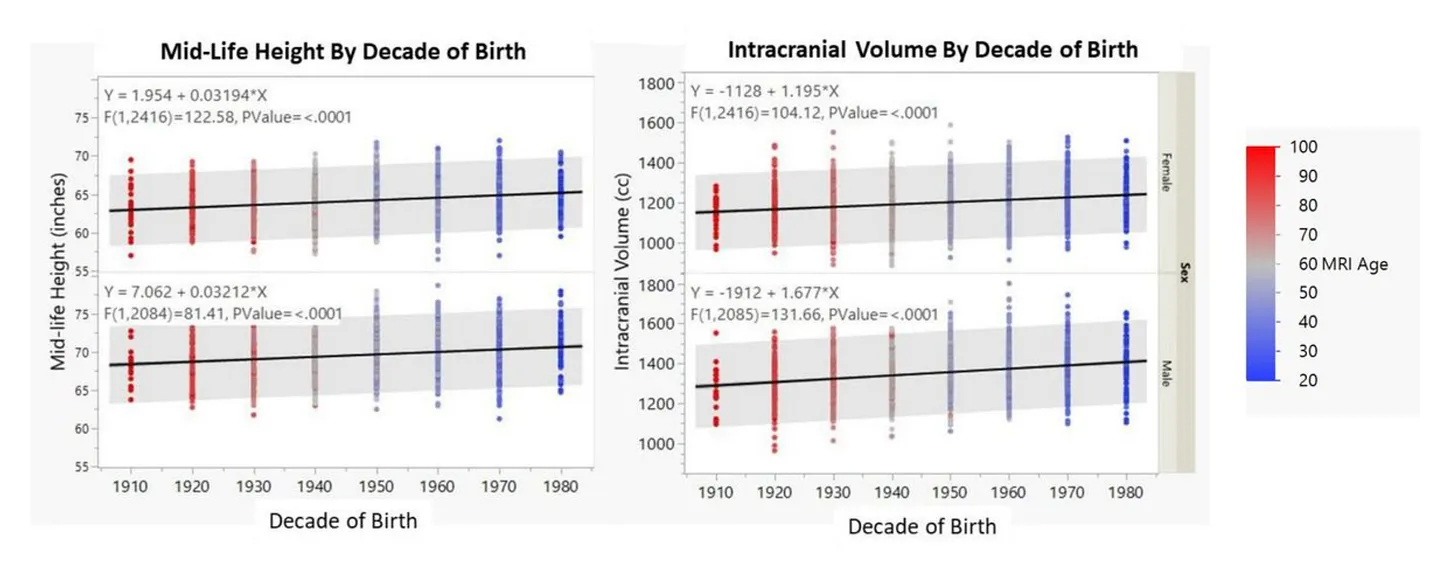 Our brains are bigger. Heights and brain volumes are both up, but interestingly, brains are growing relatively more than height. Source: Secular Trends in Head Size and Cerebral Volumes In the Framingham Heart Study for Birth Years 1902-1985
Our brains are bigger. Heights and brain volumes are both up, but interestingly, brains are growing relatively more than height. Source: Secular Trends in Head Size and Cerebral Volumes In the Framingham Heart Study for Birth Years 1902-1985
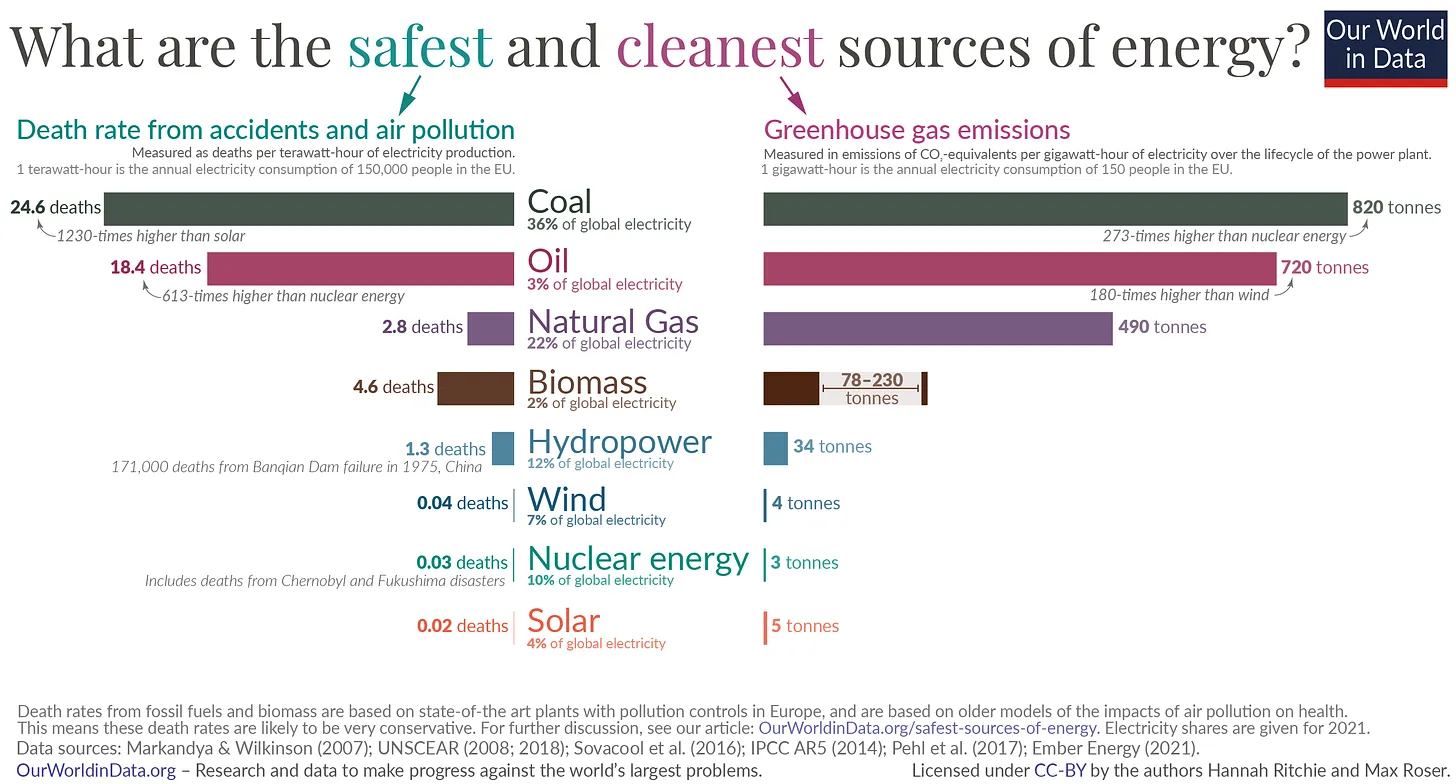 Source: Our World in Data
Source: Our World in Data
Other Interesting Reads
AI Papers & Articles
- Google Instruct Imagen [Huggingface]
- LLM augmented LLMs [Arxiv]Twitter
- Improving Text Embeddings with Large Language Models ArxivTwitter
- Self-Play Fine-Tuning Converts Weak Language Models to Strong Language Models [Arxiv]
- Mistral medium mystery [Twitter]
- Random transformers [Blog]
- Kahneman-Tversky Optimization [Blog]
Other subjects
- How much energy does the Sun produce? [Ethan Siegel]
- A 2D route to 3D computer chip [Nature]
- Why did renewables become so cheap so fast? [Our World in Data]
- Satellite mapping reveals extensive industrial activity at sea [Nature]
- Dynamical bias in the coin toss — from the moment a coin is launched into the air, its entire trajectory—including whether it lands on heads or tails—can be calculated by the laws of mechanics. The researchers determined that airborne coins don’t turn around their symmetrical axis; instead they tend to wobble off-center, which causes them to spend a little more time aloft with their initial “up” side on top. New paper supporting this.
I think I’m going to stop here.
Here’s to 2024! The future looks so bright ☀️😎